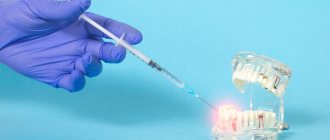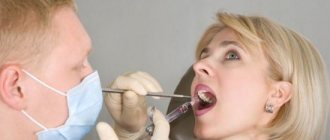Is it allowed to treat teeth during pregnancy?
Of course yes, and sometimes it’s simply necessary. A problematic oral cavity is not only decayed teeth, bad breath and unbearable pain in an inflamed tooth, but primarily the cause of the appearance and spread of infection, which must be prevented and treated at an early stage of pregnancy.
If the situation has already become complicated, the infection will spread throughout the body with pieces of food, saliva and blood. A particularly dangerous situation is when the inflammation is already located near the tooth roots, where blood vessels and bone tissue are located.
Even if during pregnancy a dental infection did not harm either the woman or the child in any way, this can happen after childbirth. After all, every mother loves to kiss and hug her newborn baby, and along with tenderness, the mother passes on her microflora to the child, including a tooth infection. If bacteria enter a child's body that is still fragile after birth, this can lead to many serious problems.
Effect of anesthesia
Sitting at the dentist's office, people are afraid of the discomfort and pain that always accompany dental treatment. But a solution has long been found - pain relief. How do pregnant women tolerate anesthesia? Are they allowed to take painkillers? Many dentists answer that such an injection is simply necessary. After all, expectant mothers will experience unnecessary anxiety and fear of feeling pain while waiting for their turn to see a doctor. And stress negatively affects the well-being and development of the baby in the womb, so she does not need worry at all and is even contraindicated.
Is it safe to give a painkiller injection to pregnant women? If we are talking about general anesthesia, then its influence can still negatively affect both the child and the expectant mother. But local anesthesia can be done using modern medications. They will perfectly anesthetize a small area of the gum, since they act in a targeted manner, and will limit the pregnant woman from terrible torment in the dental chair during the treatment process. In addition, the dose of the drug is very small, so you should not be afraid that the drug gets to the baby along with the blood; its components will still not pass through the placenta.
Lidocaine spray for local use. dosed 4.6mg/dose 38g
Registration Certificate Holder
SYNTHESIS (Russia)
Dosage form
Medicine - Lidocaine-Akos
Description
Spray for local and external use
in the form of a transparent, colorless or yellowish liquid.
1 dose
lidocaine hydrochloride monohydrate 4.6 mg
Excipients
: ethanol 96% (rectified ethyl alcohol, “Extra” grade) - 18.4 mg, propylene glycol - 4.6 mg, sodium hydroxide - 0.23 mg, sodium saccharinate dihydrate (sodium saccharin) - 0.138 mg, racementol (racemic menthol) - 0.092 mg, water purified - up to 0.046 g.
340 doses - plastic bottles with a spray nozzle (1) - cardboard packs. 650 doses - plastic bottles with a spray nozzle (1) - cardboard packs.
Indications
For terminal (superficial) anesthesia of mucous membranes: in dentistry, in otorhinolaryngology, in obstetrics and gynecology, for instrumental and endoscopic examinations, in surgery and dermatology, radiographic examination (elimination of nausea and pharyngeal reflex).
Contraindications for use
Use for tonsillectomy and adenotomy in children under 8 years of age;
hypersensitivity to lidocaine. With caution
during instrumental studies (rectoscopy) in patients with hemorrhoidal bleeding, local infection in the area of application, trauma to the mucous membrane or skin in the area of application, severe somatic pathology, epilepsy, bradycardia, cardiac conduction disorders, impaired liver function, severe shock, young children, elderly patients, during pregnancy and lactation.
pharmachologic effect
Local anesthetic for superficial anesthesia. The action is due to the blockade of voltage-dependent sodium channels, which prevents the generation of impulses at the endings of sensory nerves and the conduction of pain impulses along nerve fibers.
When applied topically, it dilates blood vessels and does not have a local irritating effect. Has an analgesic effect.
The effect develops 1-5 minutes after application to mucous membranes or skin and lasts 30-60 minutes.
Drug interactions
Cimetidine and propranolol reduce the hepatic clearance of lidocaine (decreased metabolism due to inhibition of microsomal oxidation and decreased hepatic blood flow) and increase the risk of toxic effects (including stunned state, drowsiness, bradycardia, paresthesia).
Barbiturates, phenytoin, rifampicin (inducers of microsomal liver enzymes) reduce effectiveness (an increase in dose may be required).
When prescribed with ajmaline, phenytoin, verapamil, quinidine, amiodarone, the negative inotropic effect may be enhanced. Co-administration with beta-blockers increases the risk of bradycardia.
Curare-like drugs enhance muscle relaxation.
Procainamide increases the risk of developing central nervous system excitation and hallucinations.
With the simultaneous administration of lidocaine and hypnotics and sedatives, their inhibitory effect on the central nervous system may be enhanced.
With intravenous administration of hexobarbital or sodium thiopental against the background of the action of lidocaine, respiratory depression is possible.
Under the influence of MAO inhibitors, the local anesthetic effect of lidocaine may be enhanced.
With the simultaneous use of lidocaine and polymyxin B, an increased inhibitory effect on neuromuscular transmission is possible, so in this case it is necessary to monitor the patient's respiratory function.
Dosage regimen
Apply locally, externally. The dose depends on the indications and the area of the anesthetized surface.
Side effect
Local reactions:
a slight tingling sensation that disappears as the anesthetic effect develops (within 1 minute); Transient erythema, swelling and sensory disturbances may occur.
Allergic reactions:
very rarely - urticaria, angioedema, bronchospasm; in exceptional cases - anaphylactic shock. The use of the drug should be stopped immediately if any allergic reaction occurs.
After topical application, systemic effects rarely develop, because
Only a very small amount of the active substance can enter the bloodstream. From the side of the central nervous system:
very rarely - nervous excitement, systemic dizziness, insomnia, loss of consciousness and respiratory paralysis.
From the cardiovascular system:
decreased blood pressure, depression of myocardial function, bradycardia, cardiac arrest.
special instructions
Use with caution in patients with epilepsy, as well as bradycardia, cardiac conduction disturbances, impaired liver function and severe shock, especially when significant amounts of the drug can be expected to be absorbed when large areas of tissue are treated with high doses.
It is important to prevent lidocaine from entering the respiratory tract (risk of aspiration).
Application to the buccal mucosa is associated with a risk of dysphagia and subsequent aspiration, especially in children. If the sensitivity of the tongue and mucous membrane of the cheeks is impaired, the risk of biting them increases.
Lidocaine is well absorbed through mucous membranes (especially in the trachea) and damaged skin. This should be taken into account, especially when treating large areas of tissue in children.
In cases of use during surgical operations in the pharynx or nasopharynx, it should be taken into account that lidocaine, suppressing the pharyngeal reflex, enters the larynx and trachea and suppresses the cough reflex, which can lead to bronchopneumonia. This is especially important in children, as they are more likely to trigger their swallowing reflex. In this regard, the spray is not recommended for local anesthesia before tonsillectomy and adenotomy in children under 8 years of age.
Caution should be exercised when applying lidocaine to damaged mucous membranes and/or infected areas.
Lower doses should be used in weakened and elderly patients, in acute diseases, as well as in children - in accordance with age and general condition.
Effect on the ability to drive vehicles and machinery
During the treatment period, care must be taken when driving vehicles and engaging in other potentially hazardous activities that require increased concentration and speed of psychomotor reactions.
Use during pregnancy and breastfeeding
Restrictions during pregnancy - With caution. Restrictions when breastfeeding - With caution.
If local anesthesia is necessary and no safer treatment is available, lidocaine can be used during pregnancy.
Lidocaine is excreted in breast milk, but after topical use in normal therapeutic doses, the amount excreted in milk is too small to cause any harm to a nursing infant.
Use for renal impairment
Restrictions for impaired renal function - With caution.
In chronic renal failure, accumulation of metabolites is possible.
Use for liver dysfunction
Restrictions for liver dysfunction - With caution. The drug should be used with caution if liver function is impaired.
Use in elderly patients
Restrictions for elderly patients - Use with caution.
Use with caution in elderly patients.
Use in children
Restrictions for children - Use with caution. Use with caution in children. Use for local anesthesia before tonsillectomy and adenotomy in children under 8 years of age is not recommended.
Effect of X-ray
X-rays are another factor that frightens not only pregnant women, but also ordinary people. There are a lot of myths about the negative impact of x-rays on the human body, and since a woman during pregnancy must take care not only of herself, but also of the new life within herself, it is often because of these myths that she refuses dental treatment, for fear of harming the baby.
Of course, the X-ray procedure must be approached with all seriousness, but in this case you should not be afraid of it. After all, we are talking about a targeted effect, which is strictly aimed at a small area in the oral cavity, while the woman’s chest, neck and stomach are reliably protected by a lead apron. Therefore, we can say that exposure to X-rays is minimized and cannot in any way harm either the baby or the expectant mother.
What is an ingrown toenail?
With this disease, the nail plate grows into the periungual fold. The big toe is most often affected. The disease begins with some “provoking” moment - an injury during a pedicure, a bruise, wearing tight shoes, etc. Swelling of the roller occurs, it is pressed more tightly against the nail plate and is slightly injured by it (an abrasion, a microcrack occurs). This, in turn, causes increased swelling and pain. Almost immediately an infection sets in - microorganisms invade the wound. Inflammatory phenomena gradually progress - redness appears in the area of the periungual fold, pain and swelling increase. Pus begins to secrete between the nail and the roller, and later hypergranulations appear there (the so-called “wild meat”). Before infection sets in, ingrown toenails can still be stopped by treatment at home - it will be described below. When suppuration occurs, and especially when “wild meat” appears, conservative treatment is always ineffective; it can only bring a short-term reduction in symptoms. Only surgical intervention can radically help.
Dental treatment and pregnancy
Women in special situations should visit the dentist more often than ordinary people. This will increase the chance of catching the problem early and fixing it quickly and safely. The dentist must first explain in detail and gently what he will do, what medications to use, and how this procedure will somehow affect her body or her fetus. It is important that the doctor helps the pregnant woman choose good products for cleaning her mouth, tell her what vitamins she needs to take while the baby is growing and how to properly care for her teeth.
Do pregnant women need to have their teeth pulled out or inserted? When the problem is detected at the initial stage, it will not be difficult to solve it. You will just need to clean the affected area with a drill and close it with a special solution (seal). Modern fillings do not affect a pregnant woman or her child in any way, since their components are absolutely safe.
But if the situation has already started and the infection has reached the roots of the tooth, then the doctor will have to work a little. You must first take a picture to determine how damaged the roots are, remove them, take a few more pictures, and only then proceed with filling. Since the root removal procedure is unpleasant and painful, you cannot do without an anesthetic injection.
It is much easier to restore a damaged tooth than to create a new one in its place. But if the tooth cannot be saved, then there is only one option - removal. Is it possible to have teeth removed during pregnancy? The answer is yes, if there are no contraindications. But doctors still try to save the tooth and carry out treatment with all available methods, and resort to removal only when there is no longer a chance.
As for inserting a new tooth during pregnancy, there are also no contraindications to this procedure. If the gums are healthy and there is no infection, then it is better to postpone such a procedure for a while, since the process of creating a new tooth is quite labor-intensive and will require frequent visits to the dentist.
Can pregnant women have their wisdom teeth removed? It is possible, but if the situation is not critical, then it is better to postpone such a procedure. After all, removing a healthy tooth is not an easy process, and if it is even slightly covered by gum, it will have to be cut. Such an intervention risks causing complications, for example, bleeding from the gums, pain after or increased body temperature, which is undesirable for the mother and her fetus. But if the tooth is damaged and hurts, then it is better to remove it as soon as possible.
When is the best time to treat teeth for pregnant women?
When the problem is critical, you need to consult a dentist at any time, and as soon as possible. But first, a pregnant woman needs to find out from her gynecologist whether there are any restrictions on dental treatment. If you can be patient, it is better to carry out treatment procedures in the second half of the term, since in the first and third the formation and intensive growth of the baby’s internal organs occurs, so there is a possibility that any intervention and medication will have a detrimental effect on the child’s development.
General anesthesia
General anesthesia is used only for surgical abortion. It is not required to be medicated or vacuumed. The drug is administered in the standard way: into the blood. After this, a deep medicated sleep occurs, during which the patient does not feel anything. This is a clear and significant advantage of this method.
But it also has some disadvantages:
- General anesthesia can have a number of adverse consequences, especially if the patient has diseases of the cardiovascular, respiratory, genitourinary or digestive systems.
- The administration of general anesthesia requires the presence of an anesthesiologist during the operation, which not all clinics and antenatal clinics can afford.
- To ensure safety during surgery under general anesthesia, special equipment is required, for example, a ventilator.
Therefore, general anesthesia for abortion is used only in rare cases.







